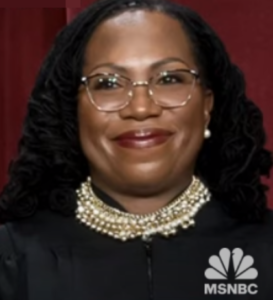Supreme Court Strikes Down Affirmative Action

“I’ve heard the word diversity quite a few times, and I don’t have a clue what it means. It seems to mean everything for everyone.” – Justice CLARENCE THOMAS
The following excerpt is courtesy of THE HILL – Supreme Court Justice Clarence Thomas read his concurring opinion from the bench Thursday, a rarity that underscored the importance he ascribes to the decision striking down affirmative action in college admissions.
Thomas, a conservative and one of two African Americans on the court, voted with the six-member majority that found the admissions programs at the University of North Carolina and Harvard University violated the equal protection clause of the 14th Amendment. He also filed his own concurrence, laying out his own reasoning for his decision, and chose to read it aloud, which does not usually happen.
Credit: thehill.com
SCOTUS affirmative action ruling blames Black students

According to published reports by MSNBC – Supreme Court Justice Ketanji Brown Jackson’s concurring dissent reads as followed: With let-them-eat-cake obliviousness, today, the majority pulls the ripcord and announces “colorblindness for all” by legal fiat. But deeming race irrelevant in law does not make it so in life…”
The History of Affirmative Action | The New York Times
How Asian-Americans became the face of Affirmative Action
Land Grant Colleges?
The Hidden Dangers of Affirmative Action
The Civil Rights Act of 1866
The Civil Rights Act of 1866 declared all persons born in the United States to be citizens, “without distinction of race or color, or previous condition of slavery or involuntary servitude.” Although President Andrew Johnson vetoed the legislation, that veto was overturned by the 39th United States Congress and the bill became law. The Civil Rights Act of 1866 was the nation’s first civil rights law.
Credit: Library of Congress, “A Century of Lawmaking for a New Nation: U.S. Congressional Documents and Debates, 1774 – 1875,” accessed July 8, 2021
The Black Codes and Jim Crow
Black codes and Jim Crow laws were laws passed at different periods in the southern United States to enforce racial segregation and curtail the power of Black voters. After the Civil War ended in 1865, some states passed black codes that severely limited the rights of Black people, many of whom had been enslaved.
Source: NationalGeographic.org
Here is a list of Black Codes and Jim Crow Laws that were historically used in the United States:
Black Codes:
Mississippi Black Code (1865)
South Carolina Black Codes (1865)
Alabama Black Code (1865)
Louisiana Black Code (1865)
Florida Black Code (1866)
Georgia Black Code (1866)
Texas Black Code (1866)
Virginia Black Codes (1865-1866)
North Carolina Black Codes (1865-1866)
Tennessee Black Codes (1865-1866)
Jim Crow Laws:
Separate Car Act (Louisiana, 1890)
Separate Coach Law (Tennessee, 1891)
Separate Car Law (Florida, 1891)
Separate Car Law (Mississippi, 1890)
Separate Coach Law (Texas, 1891)
Grandfather Clause (Various states, late 19th and early 20th centuries)
Poll Tax Laws (Various states, late 19th and early 20th centuries)
Literacy Tests (Various states, late 19th and early 20th centuries)
Residential Segregation Laws (Various states, early 20th century)
School Segregation Laws (Various states, early 20th century)
Please note that this list is not exhaustive, as Black Codes and Jim Crow Laws varied across states and evolved over time. Additionally, some laws were specific to certain localities or regions within a state. The purpose of these laws was to enforce racial segregation and restrict the rights and freedoms of African Americans during the post-Civil War Reconstruction era and well into the 20th century.
North Carolina Black Codes that were enacted during the post-Civil War Reconstruction era:
The North Carolina Apprentice Law (1865): This law required African American orphans and children of freed slaves to be apprenticed to white families, often as unpaid laborers. It effectively placed them under the control and authority of their white employers until the age of 21.
The North Carolina Vagrancy Law (1865): This law targeted unemployed African Americans and made it illegal for them to be without employment or means of supporting themselves. It gave authorities the power to arrest and fine individuals who were deemed vagrants, potentially leading to forced labor or imprisonment.
The North Carolina Labor Contract Law (1866): This law aimed to regulate labor relations between former slaves and their employers. It required African Americans to enter into labor contracts with white landowners and imposed penalties for breaches of contract. It essentially sought to maintain a form of coerced labor and control over the freed population.
The North Carolina Miscegenation Law (1868): This law prohibited interracial marriage between African Americans and whites. It declared such marriages void and imposed penalties on individuals who violated the law.
The North Carolina Segregation Laws (early 20th century): While not strictly classified as Black Codes, North Carolina, like many other Southern states, enforced various segregation laws that mandated racial separation in public facilities, transportation, schools, and other areas of daily life. These laws included the establishment of separate schools, public transportation, and segregated seating in public spaces.
It’s important to note that Black Codes varied across states, and their specific provisions and enforcement could differ. These laws were part of a larger system of racial oppression and control, aimed at maintaining white supremacy and limiting the rights and freedoms of Negroes so-called Colored, Blacks and currently African Americans during the Reconstruction period and beyond.